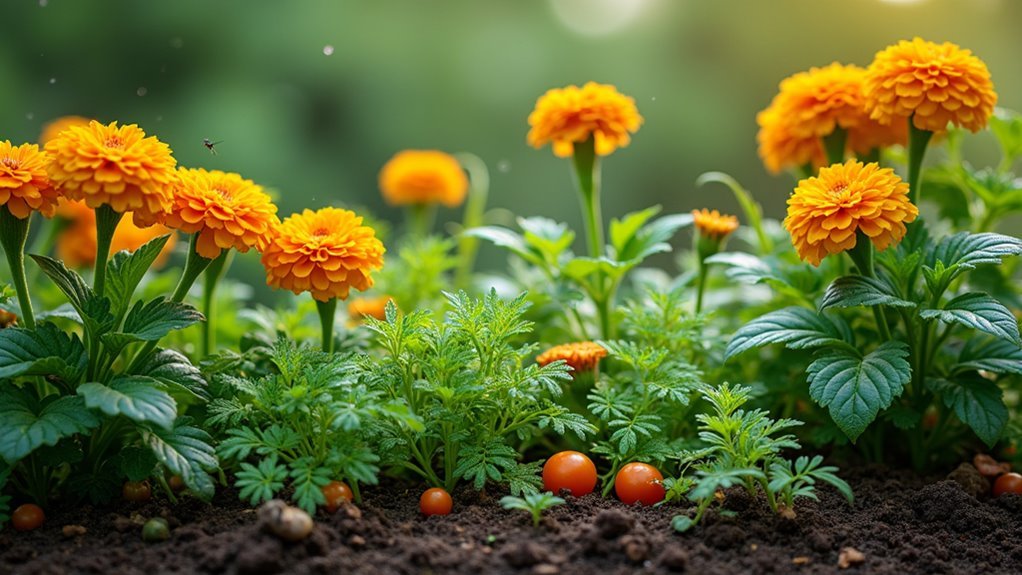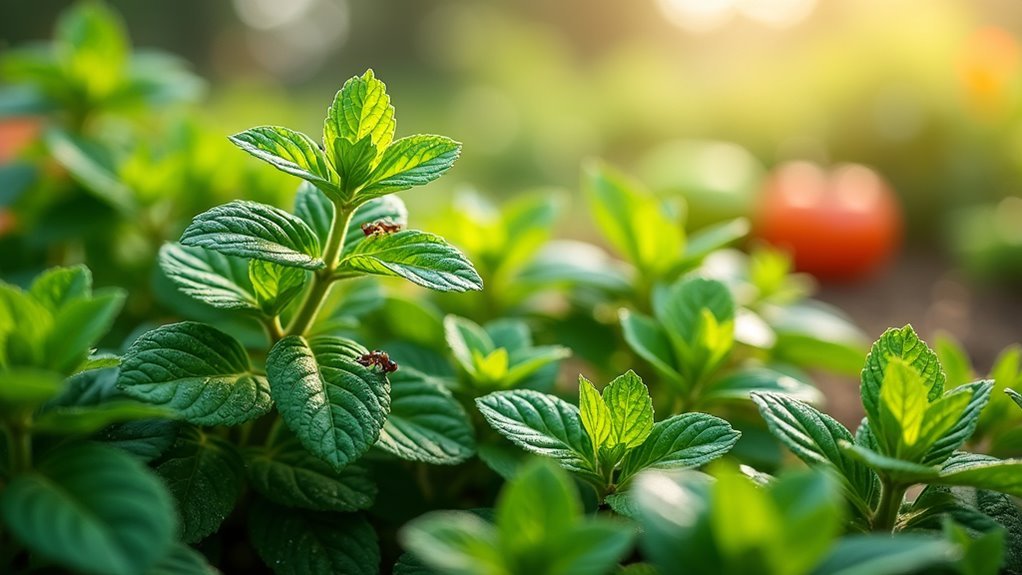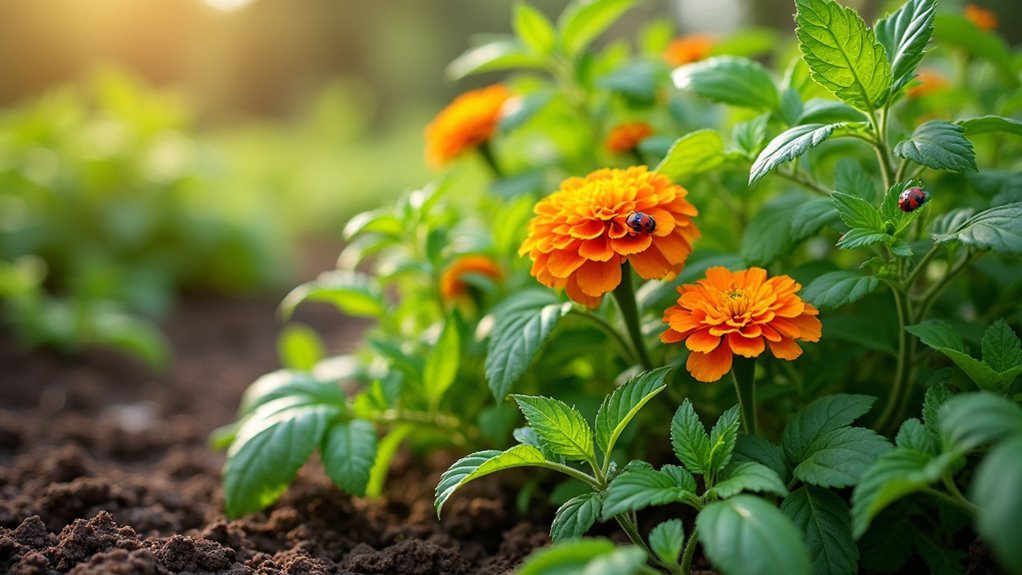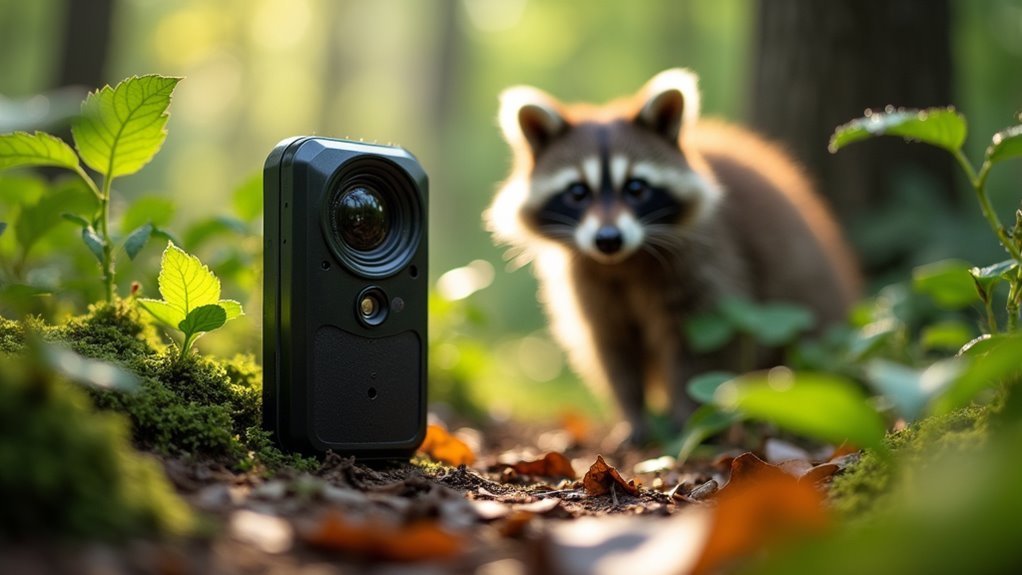You can harness nature’s chemical warfare by strategically interplanting companion plants that release protective compounds throughout your garden. Marigolds emit alpha-terthienyl to eliminate soil pests for up to three years, while nasturtiums act as trap crops to lure aphids away from valuable vegetables. Basil varieties target specific insects like whiteflies and mosquitoes, and chrysanthemums produce natural pyrethrins that disrupt over 100 insect species’ nervous systems. These partnerships can reduce pest populations by up to 90% while creating balanced ecosystems that support beneficial insects and enhance soil health through strategic plant placement.
Understanding the Science Behind Plant-to-Plant Protection

When you strategically position companion plants throughout your garden, you’re tapping into natural chemical warfare that’s been evolving for millions of years.
Your plants communicate through chemical signals, creating a sophisticated natural pest control network. Companion plants like marigolds release alpha-terthienyl, a compound that’s toxic to soil-dwelling pests for up to three years.
Plants wage chemical warfare against pests through sophisticated communication networks, with marigolds releasing toxins that protect soil for years.
Aromatic herbs such as basil and lavender confuse flying insects with their fragrances while attracting beneficial insects that hunt harmful pests.
This interplanting approach creates mutually beneficial relationships where plants protect each other. The chemical compounds released enhance soil health and create an environment where you can reduce pest populations by up to 90% without synthetic pesticides.
Marigolds: Underground Chemical Warfare Against Soil Pests
Beneath your garden’s surface, marigolds wage an invisible war against destructive soil pests through their remarkable chemical arsenal.
These vibrant flowers release alpha-terthienyl through their roots, creating effective chemical warfare against root-knot nematodes and various soil pests. French marigold varieties prove especially powerful in pest management, reducing nematode populations by up to 90%.
You’ll find marigolds thrive when interplanting alongside vegetables like tomatoes, potatoes, eggplants, and peppers. They also repel cucumber beetles and vine borers, protecting cucumbers, squash, and melons from devastating attacks.
This underground protection continues working for up to three years, continuously penetrating soil to combat root pests and enhance overall garden health through sustained natural defense mechanisms.
Nasturtiums: Strategic Sacrifice Plants for Aphid Management

You can turn nasturtiums into powerful allies by using them as trap crops that deliberately attract aphids away from your prized vegetables.
Plant these sacrificial flowers around vulnerable crops like broccoli and cabbage, then watch as aphids flock to the nasturtiums instead of decimating your harvest.
To maintain this protective barrier throughout the growing season, you’ll need to establish a strategic planting schedule that keeps fresh nasturtiums available as older ones become overwhelmed with pests.
Trap Crop Strategy
One of gardening’s most clever defensive strategies involves deliberately planting nasturtiums as sacrificial decoys to lure aphids away from your prized vegetables.
This trap crops method works exceptionally well in organic gardening, where nasturtiums act as magnets for pest control. You’ll want to establish borders around vulnerable crops like broccoli, cabbage, and apple trees to maximize aphid protection.
Stagger your nasturtium plantings every 3-4 weeks throughout the growing season for continuous pest protection.
This interplanting approach doesn’t just manage aphids—it enhances biodiversity by attracting beneficial insects and pollinators to your vegetable gardens.
Plus, you’ll enjoy the bonus of edible, peppery flowers that add both aesthetic appeal and culinary value to your harvest.
Planting Schedule Timing
While nasturtiums can be sown throughout the growing season, timing your plantings strategically maximizes their effectiveness as aphid magnets.
For best pest protection, stagger your nasturtium plantings every 3-4 weeks. This planting schedule timing guarantees continuous coverage when aphid populations peak during different growth stages of your valuable crops.
Plant nasturtiums as borders around broccoli, cabbage, and fruit trees before these crops reach vulnerable stages.
Early interplanting allows nasturtiums to establish themselves as effective companion plants for natural pest management. These sacrificial decoys will attract beneficial insects while drawing aphids away from your prized vegetables.
Basil Varieties: Targeted Defense Against Flying Insects
Although many gardeners know basil as a culinary herb, its pest-repelling properties make it one of the most versatile companion plants you can grow. Different basil varieties create targeted defenses against specific flying insects through their strong aromatic oils.
Here’s how each variety helps repel pests:
- Sweet basil and Thai basil – Combat mosquitoes and aphids effectively
- Lemon basil – Specifically targets whiteflies with its citrus scent
- Purple basil – Confuses cabbage moths protecting brassica crops
- All varieties – Create a protective barrier reducing overall pest attraction
- Companion plants for tomatoes – Plant 12-18 inches apart to enhance flavor while deterring insects
You’ll improve plant health by strategically positioning these aromatic defenders throughout your garden, creating natural pest control zones.
Mint: Aggressive Aromatics for Ant and Moth Control

When ants march across your garden beds or cabbage moths threaten your brassicas, mint’s aggressive aromatics provide a powerful defense system. This versatile companion plant repels numerous garden pests through its overwhelmingly strong scent, making it ideal for interplanting near vulnerable crops like cabbage, kale, and broccoli.
However, mint’s aggressive growth requires strategic placement in containers to prevent it from overtaking neighboring plants. Peppermint and spearmint varieties prove most effective at confusing and deterring unwanted insects.
Regular harvesting enhances mint’s pest-repelling properties while promoting healthy growth, creating a dual-purpose garden addition.
Garlic: Sulfur-Powered Root Zone Protection
Since garlic’s sulfur compounds create a protective barrier in the soil, this powerful bulb acts as your garden’s underground security system against destructive nematodes and root-dwelling insects.
When interplanted with tomatoes, peppers, and eggplants, garlic’s potent aroma enhances pest control while preserving beneficial insects above ground.
For ideal root pest protection and garden health, follow these planting guidelines:
- Space garlic cloves 4-6 inches apart with pointed ends facing upward
- Establish garlic borders around perennial beds for continuous protection
- Create organic deterrent sprays from crushed garlic and water
- Focus planting near vulnerable nightshade family crops
- Position strategically to repel soil-dwelling threats year-round
This sulfur-powered approach delivers effective, chemical-free pest management that strengthens your garden’s natural defenses underground.
Lavender: Dual-Purpose Pest Deterrent and Pollinator Magnet
You’ll find lavender’s essential oils create a powerful defense system that confuses and repels aphids, whiteflies, and cabbage moths through their strong fragrance.
While these oils disrupt harmful insects’ feeding patterns, they simultaneously attract beneficial pollinators like bees and butterflies to your garden.
This dual-action approach makes lavender an exceptional companion plant that protects your vegetables while supporting the insects you actually want around.
Essential Oil Defense
Although many gardeners focus solely on pest-repelling plants, lavender delivers a remarkable dual benefit that transforms your garden into both a fortress against unwanted insects and a haven for beneficial insects.
Lavender’s essential oils create a powerful defense system through natural gardening principles. The aromatic compounds effectively repel harmful pests while attracting pollinators vital for your garden ecosystem. This companion plant thrives in well-drained soil and sunny locations, making it perfect for interplanting with vegetables and herbs.
Lavender’s pest-repelling properties target multiple threats:
- Aphids avoid lavender’s strong fragrance
- Whiteflies stay away from aromatic compounds
- Cabbage moths find the scent overwhelming
- Beneficial insects like bees are attracted for pollination
- Plant scents get masked, confusing pest feeding patterns
Beyond pest control, you’ll enjoy culinary use in dishes and homemade remedies.
Beneficial Insect Attraction
Why settle for plants that only repel pests when you can cultivate ones that actively strengthen your garden’s ecosystem?
Lavender exemplifies perfect companion planting by simultaneously attracting pollinators like bees and butterflies while providing natural pest control. This dual-action approach transforms your garden into a thriving biodiversity hub.
You’ll find that lavender’s fragrant herbs don’t just repel aphids and cabbage moths—they’re disrupting feeding patterns through essential oil interference with pest scent trails.
Meanwhile, beneficial insects flock to lavender’s blooms, enhancing pollination throughout your garden beds.
Strategic placement maximizes these advantages, creating pollinator corridors that boost overall productivity.
Chrysanthemums: Natural Pyrethrin Production for Broad-Spectrum Control
When you’re looking for a natural pest control solution that packs serious punch, chrysanthemums deliver impressive results through their production of pyrethrins. These natural insecticides disrupt the nervous systems of over 100 insect species, making them exceptional plant companions for your garden beds.
Chrysanthemums offer these key advantages:
- Break down quickly in sunlight, providing environmentally friendly pest control
- Target common pests like aphids and beetles with broad-spectrum effectiveness
- Attract beneficial insects while controlling harmful ones
- Provide concentrated protection when interspersed throughout plantings
- Support a healthy garden ecosystem without harming beneficial populations
You’ll find these flowers serve as versatile allies in your pest management strategy, offering powerful protection while maintaining the delicate balance your ecosystem needs to thrive.
Creating Effective Plant Partnerships for Maximum Garden Defense
While individual plants like chrysanthemums provide powerful pest control, you’ll achieve superior garden defense by creating strategic partnerships between complementary species.
Interplanting marigolds with tomatoes creates a powerful alliance—marigolds repel aphids while enhancing your vegetable gardens’ overall health. You can establish trap crops using nasturtiums to lure pests away from valuable plants, concentrating damage in expendable areas.
Border your beds with garlic and onions to deter cabbage worms and slugs through their sulfurous compounds.
Herbs like basil serve dual purposes, repelling mosquitoes while improving neighboring tomato flavors.
Include zinnias and sweet alyssum to attract beneficial insects such as predatory wasps and hoverflies. These pollinators and pest predators create a balanced ecosystem where companion plants work together for maximum protection.
Frequently Asked Questions
What to Plant Next to Veggies to Keep Bugs Away?
You’ll want to plant marigolds, basil, nasturtiums, garlic, and onions near your vegetables. They’ll repel aphids, hornworms, and other pests while attracting beneficial insects that’ll protect your crops naturally.
What Plant Works as a Natural Pest Control?
You’ll find marigolds work exceptionally well as natural pest control. They release alpha-terthienyl through their roots, which is toxic to nematodes and can reduce their populations by up to 90%.
What Can I Spray on My Garden Plants to Keep Bugs Away?
You can spray garlic water, neem oil, insecticidal soap, cayenne pepper solution, or diluted essential oils like peppermint on your plants. These natural sprays effectively repel aphids, beetles, spider mites, and other common garden pests.
What Is the Best Method of Protecting Plants From Pests?
You’ll find interplanting offers the best pest protection by strategically growing companion plants together. Marigolds reduce nematodes, herbs like basil repel insects, and trap crops divert pests while promoting beneficial biodiversity naturally.
In Summary
You’ve discovered nature’s most powerful defense system right in your own backyard. By strategically placing these companion plants throughout your garden, you’ll create an invisible fortress that pests can’t penetrate. Don’t rely on a single variety—combine marigolds, nasturtiums, basil, and other defenders to build layers of protection. Your garden will thrive naturally while harmful insects find somewhere else to feast.





Leave a Reply